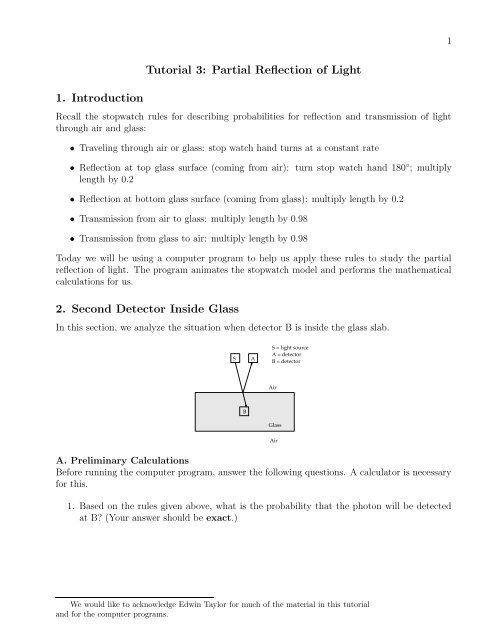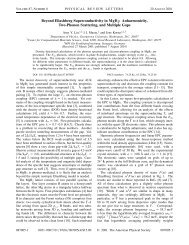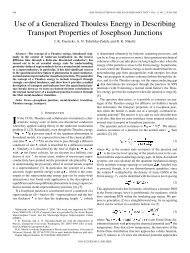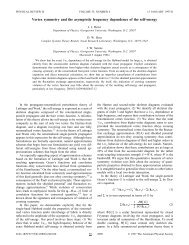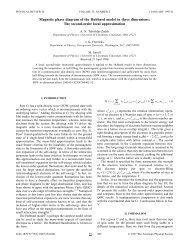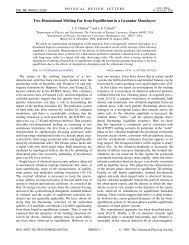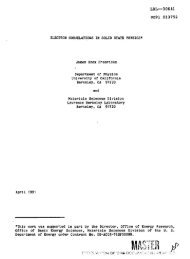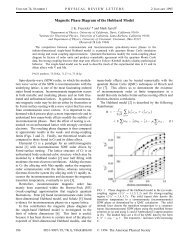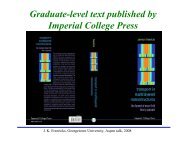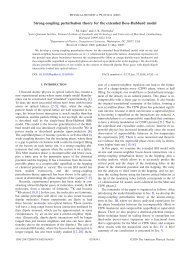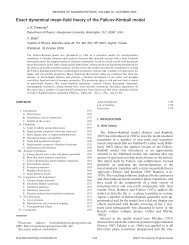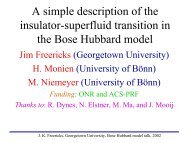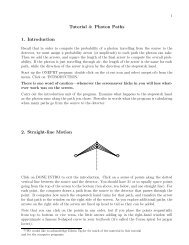Tutorial worksheet
Tutorial worksheet
Tutorial worksheet
Create successful ePaper yourself
Turn your PDF publications into a flip-book with our unique Google optimized e-Paper software.
1<br />
1. Introduction<br />
<strong>Tutorial</strong> 3: Partial Reflection of Light<br />
Recall the stopwatch rules for describing probabilities for reflection and transmission of light<br />
through air and glass:<br />
• Traveling through air or glass: stop watch hand turns at a constant rate<br />
• Reflection at top glass surface (coming from air): turn stop watch hand 180 ◦ ; multiply<br />
length by 0.2<br />
• Reflection at bottom glass surface (coming from glass): multiply length by 0.2<br />
• Transmission from air to glass: multiply length by 0.98<br />
• Transmission from glass to air: multiply length by 0.98<br />
Today we will be using a computer program to help us apply these rules to study the partial<br />
reflection of light. The program animates the stopwatch model and performs the mathematical<br />
calculations for us.<br />
2. Second Detector Inside Glass<br />
In this section, we analyze the situation when detector B is inside the glass slab.<br />
S<br />
A<br />
S = light source<br />
A = detector<br />
B = detector<br />
Air<br />
B<br />
Glass<br />
Air<br />
A. Preliminary Calculations<br />
Before running the computer program, answer the following questions. A calculator is necessary<br />
for this.<br />
1. Based on the rules given above, what is the probability that the photon will be detected<br />
at B? (Your answer should be exact.)<br />
We would like to acknowledge Edwin Taylor for much of the material in this tutorial<br />
and for the computer programs.
Physics 008—<strong>Tutorial</strong> 3: Partial Reflection of Light 2<br />
2. Based on the rules given above, what is the probability that the photon will be detected<br />
at A? (Your answer should be exact.)<br />
3. What is the exact value of the sum of these probabilities? This sum gives the probability<br />
that the photon will be detected either at A or at B.<br />
4. Assuming that any photon leaving the source winds up at A or B (i.e., no photon goes off<br />
in another direction), what value should these probabilities add up to? Explain why. Do<br />
they?<br />
5. Find a more accurate value (good to 4 decimal places) for the amount by which the arrow<br />
shrinks at each transmission, such that the sum of the probabilities does add up to your<br />
answer above. Hint: the probability that the photon will be detected at A determined in<br />
problem 2 is correct. (This is the value used by the computer program.)<br />
B. Computer Exercises<br />
Now start up the RFLCT program by first clicking on the shortcut to H:PHYS-008/QM and<br />
then dragging rflct.ctb onto the blue CT Executor icon.<br />
To explore the case with a detector in the glass, click on the ‘2ND DETECTOR’ button. Click<br />
anywhere inside the glass in the left panel to set the location of Detector B. To begin the<br />
simulation, click on ‘START.’<br />
6. Approximately how many revolutions does the original air clock make for the downward<br />
first portion of the path between A and the top of the glass?<br />
7. Place Detector B at several different locations inside the glass. Does the probability for<br />
detection at A depend on the location of B?<br />
8. Does the probability for detection at B depend on the location of B inside the glass?<br />
9. Describe everything that changes concerning detection at B for different locations of B<br />
inside the glass.<br />
10. Describe everything that changes concerning detection at A for different locations of B<br />
inside the glass.
Physics 008—<strong>Tutorial</strong> 3: Partial Reflection of Light 3<br />
3. Single Detector at A<br />
Here we consider the situation in which there is a detector at A only.<br />
S<br />
A<br />
S = light source<br />
A = detector<br />
Air<br />
Glass<br />
Air<br />
A. Preliminary Calculations<br />
Answer these questions without using the computer program. Assume three significant digits<br />
in these calculations (arrow lengths change by factor of 0.980 for transmission, and 0.200 for<br />
reflection). Give your answers to three significant digits.<br />
1. What is the length of the arrow after the photon enters the glass in its first downward path<br />
inside the glass?<br />
2. What is the length of the arrow after the first reflection from the lower surface of the<br />
glass?<br />
3. What is the length of the arrow after transmission back into the air at the upper surface<br />
of the glass?<br />
4. Does changing the thickness of the glass change in any way the arrow associated with the<br />
path from S to A involving a reflection off the bottom surface of the glass? Explain your<br />
answer.<br />
5. The diagram above shows two paths through which a photon can arrive at A: one involving<br />
a reflection off the top surface of the glass, and one involving a reflection off the bottom<br />
surface of the glass. What is the maximum length possible for the final arrow obtained<br />
by adding the arrows for the two paths?<br />
Sketch an example of how the arrows for the two paths look when the final arrow has this<br />
maximum length.<br />
6. What is the maximum probability that the photon will be detected at A?
Physics 008—<strong>Tutorial</strong> 3: Partial Reflection of Light 4<br />
7. What is the minimum length possible for the final arrow obtained by adding the arrows<br />
for the two paths?<br />
Sketch an example of how the arrows for the two paths look when the final arrow has this<br />
minimum length.<br />
8. What is the minimum probability that the photon will be detected at A, to three significant<br />
digits?<br />
Two students are having a discussion about the partial reflection of light:<br />
• Beavis: This partial reflection stuff is cool! I got that the minimum probability for the<br />
photon to arrive at A was not zero, it just was very small. Perhaps something else is going<br />
on to make the total probability zero.<br />
• Butthead: No buttmunch, the professor said to measure the probability to three significant<br />
digits which is zero. There isn’t anything else going on.<br />
With which student do you agree or disagree. Explain why.<br />
B. Computer Exercises<br />
Click on the buttons ‘FAST’ and ‘DETECTOR A ONLY.’ Use the ‘CHANGE GLASS WIDTH’<br />
option and the ‘GRAPH’ feature to answer the following questions.<br />
You will need to run the program many times to produce the graphs you need. I suggest that<br />
you switch to the fast mode on the program, once you feel comfortable with how the program<br />
runs (you can select fast mode only after choosing NEW CASE).<br />
9. What thickness of glass nearest to 100 pixels gives a minimum in the probability for reflection?<br />
10. What thickness of glass (either larger or smaller) nearest to your answer above gives the<br />
next maximum in the probability for reflection?<br />
11. What is the smallest thickness of glass (in pixels) for a maximum in the probability of<br />
detection at A?<br />
12. What is the smallest thickness of glass (in pixels) for a minimum in the probability of<br />
detection at A?<br />
13. Are the glass thicknesses corresponding to maxima in the probability for reflection equally<br />
spaced? Explain why or why not.
Physics 008—<strong>Tutorial</strong> 3: Partial Reflection of Light 5<br />
4. Using a Different Color of Light<br />
The stopwatch hand rotates at different rates for different colors of light. We have been using<br />
red light so far. Let’s see how things change with blue light.<br />
A. Preliminary Calculations<br />
1. Consider the path from the source to detector A that goes through a single reflection at the<br />
top surface of the glass. In what way(s) does the arrow associated with this path change if<br />
the stopwatch hand is rotating at a faster rate?<br />
2. Now consider the other path–the one that reflects off the bottom surface of the glass. In<br />
what way(s) does the arrow associated with this path change if the stopwatch is rotating<br />
at a faster rate?<br />
3. Taking into account these two alternate paths, what are the minimum and maximum<br />
probabilities that a photon will be detected at A if blue light is used instead of red?<br />
4. Will the minimum in the probability of detection at A occur at the same glass thickness<br />
for blue light as for red? Why or why not?<br />
Computer Exercises<br />
Select the ‘BLUE’ option. We will continue to use the ‘DETECTOR A ONLY’ setup.<br />
1. Approximately how many revolutions does the original air clock make for the downward<br />
portion of the path between A and the top of the glass?<br />
2. What is the smallest thickness of glass (in pixels) for a maximum in the probability of<br />
detection at A?<br />
3. What is the smallest thickness of glass (in pixels) for a minimum in the probability of<br />
detection at A?<br />
4. Sketch a graph showing how the probability of detection at A depends on the thickness of<br />
the glass on the next page. Include curves for red light and blue light on the same graph.
Physics 008—<strong>Tutorial</strong> 3: Partial Reflection of Light 6<br />
Prob. of detection at A<br />
20%<br />
10%<br />
0%<br />
0 10 20 30 40 50 60<br />
Thickness of glass in pixels


